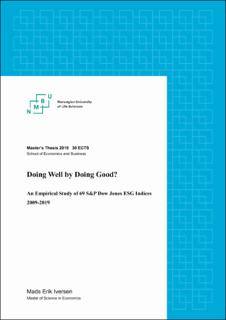| dc.contributor.advisor | Gjølberg, Ole | |
| dc.contributor.author | Iversen, Mads Erik | |
| dc.date.accessioned | 2020-02-19T13:24:16Z | |
| dc.date.available | 2020-02-19T13:24:16Z | |
| dc.date.issued | 2019 | |
| dc.identifier.uri | https://hdl.handle.net/11250/2642618 | |
| dc.description.abstract | This thesis discusses whether one sacrifices returns by investing in Environmental, Social and Governance (ESG) screened portfolios. Assuming that the ESG investments are channelled into funds that are trading one of the many S&P ESG indices, I analyse the performance of these investments using S&P Global 1200 as the benchmark. I focus on tracking error, information ratio and alpha to investigate whether the 69 S&P Dow Jones ESG Indices have outperformed, underperformed or performed in line with the benchmark.
The empirical analysis is aligned with previous studies on performance and compositions of ESG indices compared to the benchmark, and the conclusion is manifest. On average the ESG indices underperform on overall risk-adjusted return the S&P Global 1200. Among the worst or best performers, neither positive nor negative screening is significant. Bottom performers have had inferior risk and return due to the indices tilted towards the industry sector, the European market and constituent size. While top performers have gained due to tilt towards technology and exposure to the U.S market. The Fama-French approach with adjusting for fluctuations in the value and size premiums, do not indicate any difference whether the investing style is tilted in any directions. However, the indices exposure to the market premium is significant low for top and high for bottom performers. The relative performance measures showed positive information ratios for indices with exposure to Carbon and the U.S market due to the relative low tracking error, while Europe and Emerging market registered high negative information ratios caused by relative high tracking error. As a result, this thesis shows that environmental, social, and governance investor should have selected Climate instead of Thematic and Core ESG indices to have enhanced the probability of risk-adjusted returns compared to the S&P Global 1200. | en_US |
| dc.language.iso | eng | en_US |
| dc.publisher | Norwegian University of Life Sciences, Ås | en_US |
| dc.rights | Attribution-NonCommercial-NoDerivatives 4.0 Internasjonal | * |
| dc.rights.uri | http://creativecommons.org/licenses/by-nc-nd/4.0/deed.no | * |
| dc.subject | ESG | en_US |
| dc.subject | Index performance | en_US |
| dc.subject | Finance | en_US |
| dc.title | Doing well by doing good? : an empirical study of 69 S&P Dow Jones ESG Indices 2009-2019 | en_US |
| dc.type | Master thesis | en_US |
| dc.description.version | submittedVersion | en_US |
| dc.subject.nsi | VDP::Social science: 200::Economics: 210::Economics: 212 | en_US |
| dc.subject.nsi | VDP::Social science: 200::Economics: 210::Business: 213 | en_US |
| dc.source.pagenumber | 57 | en_US |
| dc.description.localcode | M-ECON | en_US |

